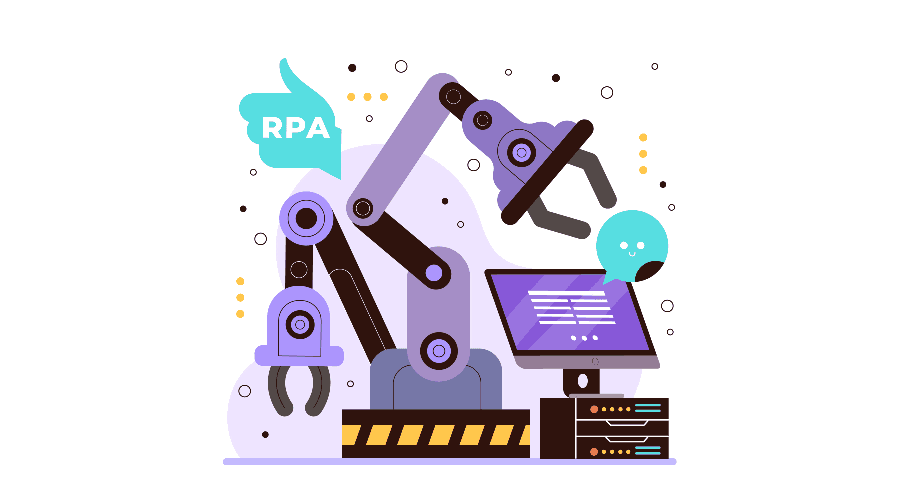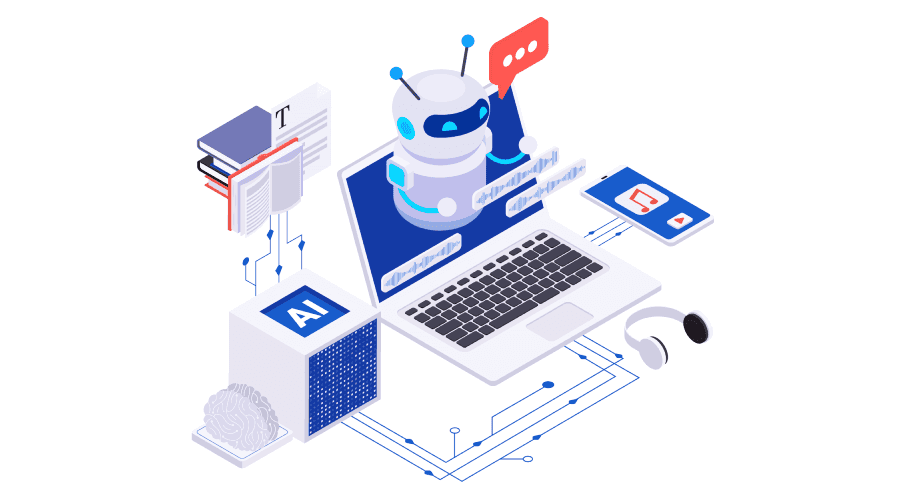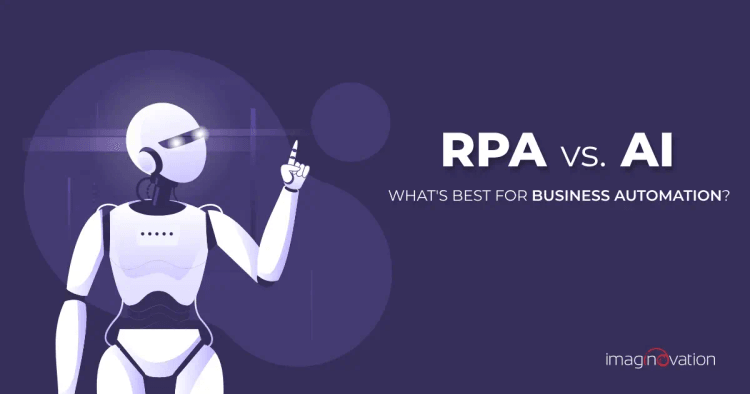Higher productivity. Increased efficiency. Cost savings. The perks of business automation technologies are widely known. However, when it comes down to it, business owners aren't sure which automation technology to use.
This article seeks to shed light on two of the most popular ways of business automation: RPA and AI. You will learn the primary difference between the two and how each can benefit your business. Here's a detailed RPA vs AI comparison.
Understanding RPA and AI
RPA is the short form for Robotic Process Automation. This emerging technology is designed to perform repetitive tasks by following a set of pre-determined rules.
It uses software robots (bots) to mimic human actions like typing on keyboards, clicking icons, and accessing data systems. The goal of RPA is to handle an organization’s most mundane tasks, which frees staff to focus on other high-value operations.
Here are the main features of an RPA application:
- It’s a rule-based technology, which means it can only work by following the clearly stated steps and directions configured into the system.
- Does a stellar job of automating repetitive tasks
- It does not require any coding knowledge- RPA is a user-friendly solution that doesn’t need any prior coding knowledge. Just train your staff on how to use it, and you’re good to go!
Conversely, Artificial Intelligence (AI) represents a fusion of technologies with cognitive ability. While RPA technology imitates human actions, AI imitates human thinking patterns. AI’s cognitive capability renders it useful for tasks that require reasoning, learning, self-correction, and decision-making.
It’s important to note that AI doesn’t refer to just one system. It combines several smart technologies: machine learning, deep learning, natural language processing (NLP), and image and voice recognition.
The Role of RPA in Business Automation
RPA plays a crucial role in streamlining business processes. From automating repeatable chores to minimizing the risk of error and saving time, this technology has proven beneficial in several facets. Here are five ways that RPA can streamline enterprise operations:
Automating Repeatable Tasks
RPA’s ability to automate repeatable tasks is one of its greatest benefits. The technology can be configured to automatically enter data, generate reports/ customer responses, and process invoices. This increases efficiency as you don’t have to rely on employees to handle these chores.
Accelerating Productivity
Automation aside, deploying RPA technology in your business also boosts productivity levels. These bots can handle significantly more work than their human equivalents. Plus, they can be set to run during off-hours. This helps your business get more work done quickly and with minimal effort.
Increasing Precision
Whether you are copy-pasting data, reconciling information, or processing an invoice, it’s important to be accurate. After all, the quality of the results depends largely on this precision.
With RPA, you’re guaranteed to get accurate results each time. The bots are designed to operate the same way each time, cutting down the risk of error to zero.
Suitable RPA Applications in Business
Here are seven business processes that benefit the most from RPA technology:
- Data entry - use it to copy-paste data from one system to another
- Invoicing - RPA can be used to generate invoices automatically based on preset guidelines
- Payroll processing - use this tool to gather, verify, and process employees’ payroll details
- Report generation - you can also design it to generate reports automatically based on predetermined templates
- Quality control - save time by automating the quality control process with RPA. In this case, the tech is used to spot errors or defects without the help of humans.

The Power of AI in Business Innovation
AI has had a profound impact on business innovation. It continually modifies how organizations run, recommending new areas to streamline operations and improve efficiency.
Here are some of the ways that AI contributes to business innovation:
Advanced-Data Analysis
One of the greatest applications of AI is in data analysis. AI technology is capable of combing through massive amounts of data to identify relationships between variables.
It can recognize trends, anomalies, and patterns that a data analyst could have otherwise overlooked. Besides, relying on AI for data analysis leads to better consistency and precision, which can be difficult to accomplish with human input.
Predictive Modeling
AI has also proven indispensable in a company’s predictive analysis efforts. AI uses deep learning and machine learning to analyze previous and current data and forecast the future.
This AI-driven predictive modeling is applied in an array of industries. For instance, insurance firms use this technology to predict which other policies clients might be interested in. Banks leverage it to predict the risk of fraudulent activity. Similarly, hotels and resorts use it to predict the dates they will likely be booked out.
Enhanced Decision-making
AI prides itself on being able to analyze mounds of data in real-time. This offers business owners valuable insight into current operations, helping them make more informed decisions.
To put things into perspective, consider the use of AI in the finance sector. Companies that adopt AI-driven financial systems can analyze vast amounts of customer data simultaneously. In doing so, they can identify areas to save costs and minimize risk.
RPA vs. AI: Key Differences and Synergies
Both RPA and AI are great for automating business operations. However, these technologies use different approaches, making them fit for specific applications. Below is a detailed breakdown of the differences and synergies between RPA and AI.
Function
The main difference between RPA and AI lies in their functions. RPA is designed to mimic human actions, while AI simulates human intelligence.
While both technologies can automate business processes, AI goes a step further. It helps with reasoning, extracting relevant information, analyzing data, and offering recommendations.
Configuration
RPA systems are designed to work by following predefined rules. Essentially, users have to configure certain guidelines to enable ingrained capabilities. AI systems require complex programming. But once they’re set, they can run independently by establishing their own configurations.
Implementation
RPA solutions are much easier to implement than their AI counterparts. Businesses have a myriad of zero-code and low-code RPA solutions to choose from. In contrast, implementing AI technology is a fairly intricate process involving a decent amount of programming.
Adaptability
Both RPA and AI solutions are adaptable. However, the level and nature of flexibility differ significantly.
With RPA, human intervention is needed to alter any system element. However, AI systems can make autonomous adjustments based on previous experiences and the data captured.
Disruption
RPA and AI solutions lead to significant changes in business operations. However, implementing RPA technology causes a less drastic shift compared to AI.
Think of RPA solutions as virtual assistants who help take care of the most repetitive tasks of your enterprise. This way, workers can spend their time in more valuable roles, such as making strategic decisions. AI technology causes a more extreme change and can even make people redundant.
Using AI and RPA to Achieve Holistic Automation Strategy

As discussed above, it’s clear that RPA and AI each have specific traits that make them unique. RPA is known for its rule-based mode of operation, while AI boasts advanced features like machine learning and computer vision.
Nonetheless, they also share a few attributes. AI and RPA intersect at several junctions, from their shared automation benefits to integration and persistent evolution.
This leads to a synergistic blend that maximizes business automation and innovation. Here are some of the ways in which RPA and AI are similar:
- Both RPA and AI help businesses by automating different processes, albeit at different complexity levels
- They also rely on data - RPA uses data to execute tasks, whereas AI uses data for continuous learning
- RPA and AI are designed to integrate seamlessly with existing IT infrastructure. This leads to increased efficiency and range of use.
Given their similarities, businesses can make the most of automation technology by combining RPA and AI. Some areas can benefit from mixed technology use, such as:
- Decision Making - Blending AI’s cognitive capabilities with RPA’s ability to handle routine tasks allows for strategic decision-making. The RPA solution can be used to gather relevant data, enabling AI to make informed, intricate decisions.
- Streamline Operations - RPA and AI can be used jointly to achieve a seamless workflow. Let’s say that the marketing department is looking to develop a campaign. They can use AI to analyze present customer data and predict which leads will be the most receptive to a given offer. Meanwhile, RPA can be used to automate the sending of targeted emails.
- Improve customer experience - when integrated with RPA, AI can evaluate customer data in real-time. This enables the RPA bots to personalize interactions and responses to customers.
Choosing Between RPA and AI for Your Business
When it comes to picking between RPA and AI, there’s no one-size-fits-all. This decision is determined on a case-by-case basis based on factors such as the complexity of functions, business objectives, and the need for learning capabilities.
Complexity of Tasks
Consider the complexity of the work you plan to use the technology for. Are you looking to automate simple tasks like copy-pasting data and processing customer orders? If so, then RPA is the best choice.
However, if you’re looking for software that can handle more sophisticated tasks, then AI is a better option. Remember, AI goes beyond mimicking human actions. It also makes cognitive decisions like predictions and classifications based on the data it’s fed.
Business Objectives
Before you decide which technology to implement, think about the strategic goals of your business.
Are you searching for an application that will go beyond basic automation? Perhaps one that can spot and correct anomalies in real time? If this is the case, you’re better off investing in AI than RPA.
Learning Capabilities
Also worth considering is the learning capability of each technology. Are you looking for software that will deliver the same results each time? Or, would you like one that learns from past experiences and adapts accordingly? If it’s the former, go with RPA; if it’s the latter, invest in AI.
The beauty of AI is that it relies on complementary technologies like machine learning. This enables it to learn patterns from previous tasks and make changes accordingly.
Implementation Process
The last factor you should consider is implementation. Specifically, evaluate your current business resources and determine if they’re enough to adopt the desired technology.
RPA is cheaper and easier to implement as it doesn’t require any programming expertise. On the flip side, this technology has limited applications as it can’t adapt to new situations. Conversely, AI is pricey and requires technical skills to implement. However, its ability to learn, adapt, and overcome unforeseen challenges gives it an edge.
Conclusion
In a nutshell, RPA is a rule-based application that automates mundane tasks. In contrast, AI is a collective term for technologies that imitate our thinking patterns. These automation technologies offer incredible benefits, including cost and time savings, increased efficiency, and higher productivity.
Are you considering integrating RPA, AI, or both tools into your business? We can help! We will work with you to assess your enterprise’s use cases and recommend the best areas for deployment. This way, you can be sure of getting the maximum ROI of your investment. Get in touch today!
Let's Talk.
Ready to build an app, but not sure where to start?
We've got you covered. Click the button below to get started.





